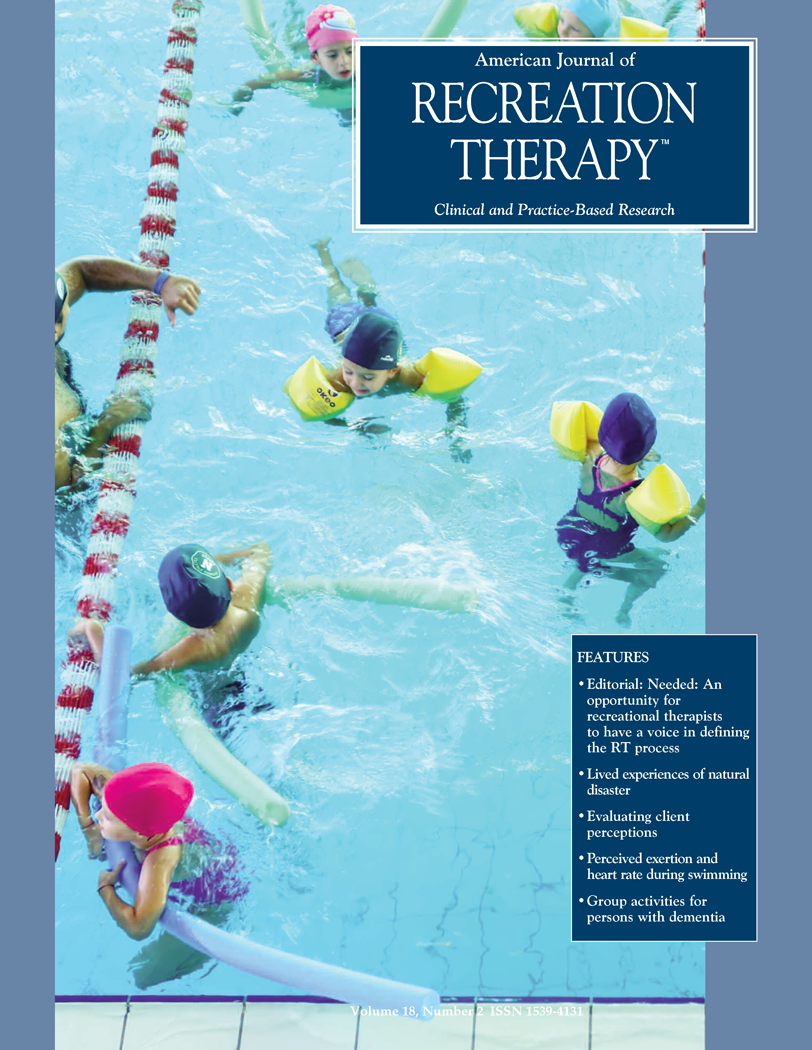A case study of children’s lived experience and meaning of a natural disaster
DOI:
https://doi.org/10.5055/ajrt.2019.0185Keywords:
post-traumatic stress disorder, recreational therapy, natural disasterAbstract
The purpose of this study was to document how children described their experiences of an unanticipated natural disaster in the form of a flood which followed a hurricane, focusing on strategies that helped them cope with the event. Four participants engaged in a qualitative study, which was conducted 6 years after the disaster. A qualitative analysis of the data was conducted. The overarching theme that emerged from the analysis was coping with the experience during the following time frames: (a) during the disaster, (b) immediately after the disaster, and (c) continued long-term effects post-disaster. Findings provide insight into children’s post-disaster experiences and clinical implications for recreational therapy.
References
Lazarus RS, Folkman S: Stress, Appraisal, and Coping. New York: Springer, 1984.
Shannon MP, Lonigan CJ, Finch AJ, et al.: Children exposed to disaster: Epidemiology of post-traumatic symptoms and symptom profiles. J Am Acad Child Adolesc Psychiatr. 1994; 33(1): 80-93.
Vernberg E, Vogel J: Interventions with children after a natural disaster. J Clin Child Psychol. 1993; 22(4): 485-498.
National Weather Service Wilmington, NC: Break the Grip of the Rip [Media Event]. Wrightsville Beach, NC: National Weather Service, 2004. Available at https://www.weather.gov/ilm/EducationandOutreach. Accessed September 27, 2018.
Ting M, Camargo SJ, Li C, et al.: Natural and forced north Atlantic hurricane potential intensity change in CMIP5 models. Am Meteorol Soc. 2015; 25: 3926-2942.
Goldenberg S, Landsea CW, Mestas-Nunez AM, et al.: The recent increase in Atlantic hurricane activity: Causes and implications. Sci Mag. 2001; 293: 474-479.
Arnell NW, Gosling SN: The impacts of climate change on river flood risk at a global scale. Clim Change. 2016; 134: 387-401.
David SD, Baish S, Morrow BH: Uncovering the hidden costs of coastal hazards. Environment. 1999; 41: 10-19.
Shelby JS, Tredinnick MG: Crisis intervention with survivors of natural disaster: Lessons from Hurricane Andrew. J Counsel Dev. 1995; 73: 491-506.
La Greca AM, Silverman WK, Wasserstein SB: Children’s predisaster functioning as a predictor of posttraumatic stress following Hurricane Andrew. J Consult Clin Psychol. 1998; 66: 883-892.
Moore S, Daniel M, Linnan L, et al.: After Hurricane Floyd passed: Investigating the social determinants of disaster preparedness and recovery. Fam Commun Health. 2004; 27(3): 204-217.
Garcia D, Siddiqui A: Adolescents’ affective temperaments: Life satisfaction, interpretation, and memory of events. J Posit Psychol. 2009; 4(2): 155-167.
Nurcombe B: The child as a witness: Competency and credibility. J Am Acad Child Psychiatr. 1986; 25(4): 473-480.
Terr L: What happens to early memories of trauma? A study of twenty children under age five at the time of documented traumatic events. J Am Acad Child Adolesc Psychiatr. 1988; 27(1): 96-104.
Jones L: Pattillo elementary principal relates his school’s story. The Daily Southerner. November 12, 1999: 6.
Miles MB, Huberman AM: Qualitative Data Analysis: An Expanded Sourcebook. 2nd ed. Thousand Oaks: Sage, 1994.
Carter MJ, Van Andel GE, Robb GM: Therapeutic Recreation: A Practical Approach. 3rd ed. Prospect Heights, IL: Waveland Press, Inc, 2003.
Russoniello CV: Recovering from hurricanes and flooding over time: Lessons learned from a child cohort [Abstract]. Proc Soc Behav Med U S A. 2006; 27: S187.
Published
How to Cite
Issue
Section
License
Copyright 2000-2025, Weston Medical Publishing, LLC and American Journal of Recreation Therapy. All Rights Reserved.


